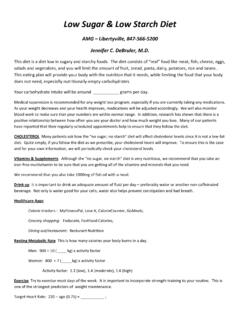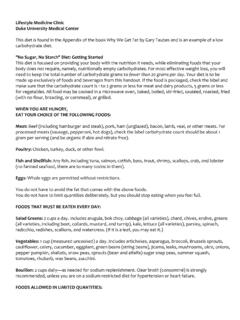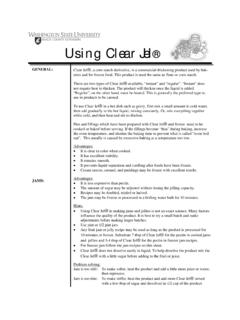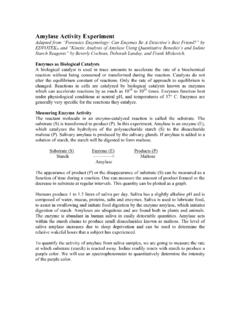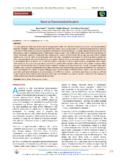Transcription of Enzymatic Digestion of Starch by Amylase
1 1. Enzymatic Digestion of Starch by Amylase Page Table of Contents 1. Activity Overview 2. Objectives 2. Content Standards 2. Materials 3. Safety 3. Background Information 3-4. Time Requirements and Preparation 5. Procedure 6. Example 5E Outline 7. Extension Ideas 8. Supplemental Resources 9. 2. - TEACHER GUIDE - Enzymatic Digestion of Starch by Amylase OVERVIEW. This lab aims to improve students' understanding of enzymes, their properties and functions, as well as their diverse applications. Students will design their own experiments in order to investigate factors that affect enzyme-catalyzed reactions. Specifically, students will alter reaction conditions (such as temperature, pH, and source of Amylase ) and determine the effects on the rate of breakdown of Starch into simple sugars by the enzyme Amylase . OBJECTIVES.
2 Students will Understand that enzymes are proteins that catalyze biochemical reactions and that the activities of enzymes depend on various conditions, such as temperature and pH. Explain the structure and function of enzymes and their applications in human and industrial processes. Evaluate the effects of various parameters ( , temperature, pH, and source of Amylase ) on the rate of Enzymatic Digestion of Starch by Amylase . CONTENT STANDARDS. This lesson is appropriate for high school biology and chemistry students and addresses the following Next Generation Science Standards: Disciplinary Core Ideas: HS-LS1 (From Molecules to Organisms: Structure and Processes). HS-PS1 (Matter and its Interactions). HS-PS1-5. Apply scientific principles and evidence to provide an explanation about the effects of changing the temperature or concentration of the reacting particles on the rate at which a reaction occurs.
3 Science and Engineering Practices: Asking Questions and Defining Problems Planning and Carrying Out Investigations Analyzing and Interpreting Data Using Mathematics and Computational Thinking Constructing Explanations and Designing Solutions Engaging in Argument from Evidence Obtaining, Evaluating, and Communicating Information Crosscutting Concepts: Structure and function 3. MATERIALS. Alpha- Amylase Starch Tap water Beakers to prepare Starch and Amylase stock solutions Conical vials (or small beakers) for each group to have their own Starch and Amylase solutions Iodine Small vials for each group to have their own iodine Spotting plates with wells Buffers at various pHs (or other acid/base solutions to test the parameter of pH). Hot plate Stir rod or stir bar Ice Thermometer Timer Beakers for water baths Test tubes Test tube rack Graduated droppers SAFETY.
4 Students and instructors should wear personal protective equipment such as safety glasses or goggles, gloves, closed-toe shoes, long pants, and lab coats at all times during this lab activity. Long hair and loose clothing should be pulled/tied back. Hot water, glassware, and acidic/basic solutions are all potential safety hazards in this lab activity. Students and instructors must handle these materials carefully using appropriate lab safety practices. Broken glassware and reagents should be disposed of properly. Always ensure that students understand and adhere to safe laboratory practices when performing any activity in the classroom or lab. Model proper laboratory safety practices for your students, demonstrate the protocol for correctly using the instruments and materials necessary to complete the activities, and emphasize the importance of proper usage.
5 BACKGROUND INFORMATION FOR TEACHERS. When we think of Starch , we commonly think of starchy foods - potatoes, rice, pasta, corn - and their role in the human diet. However, Starch from plants has other important and familiar applications. For instance, Starch is broken down into its sugar components, which are used in the production of biofuels and bioplastics. Starch is a polysaccharide made up of two components, amylose and amylopectin. These two polymers consist of glucose monomers that are joined by glycosidic bonds (see figure below). 4. The enzyme Amylase catalyzes the breakdown of Starch into glucose molecules. Amylase is found in our saliva, for instance, and initiates the digestive process by starting to break down the Starch that we eat. Enzymes are proteins that can (a) carry out a specific reaction and (b) do so multiple times without getting used up.
6 For example, although Amylase can break down the alpha-glycosidic bonds that join glucose subunits in Starch , it cannot break apart the ( -1 4)-glycosidic bonds that join glucose subunits in cellulose (cellulose is an important structural component in plant cell walls), despite the fact that both Starch and cellulose are made up of bonded glucose subunits. Amylase enzymes selectively cleave the type of glucose-to-glucose bond found in Starch , not the kind of glucose-to-glucose bond found in cellulose. Another example is that Amylase cannot break down proteins, which are chains of amino acids, while proteases, which break down proteins, cannot break down Starch . Enzymes are sensitive to their environment. Examples of what we mean by environment are things such as the temperature an enzyme is in or the acidity of the liquid they are in.
7 If an enzyme is heated too much it will misfold and change its shape. Starch is generally insoluble in water at room temperature. However, at higher temperatures (optimal temperature is 37 C), hydrogen bonds in Starch are weakened and broken, exposing amylose and amylopectin and allowing Amylase to hydrolyze glycosidic bonds. An easy way to track the rate of reactions catalyzed by enzymes is by means of indicators. For the reaction under study, iodine solution is used as a Starch indicator (tests for the presence of Starch ) and can be used to track the Digestion of Starch by Amylase . Iodine is typically orange-yellow in color, and in the presence of Starch it becomes blue-black. When the iodine atoms in the indicator are diluted in a water solution they are arranged in random order in the liquid. When they are randomly distributed they have a light yellow color.
8 However, when Starch is added to the water solution it binds to iodine and organizes it in a non-random arrangement. Iodine in this non-random arrangement imposed by the Starch chain is blue. When Starch gets broken down into glucose it can no longer arrange iodine non-randomly, so the solution turns yellowish clear again. 5. TIME REQUIREMENTS. Prep time: 30 minutes Class-time: 1 to 2 class periods, depending on class duration (50 or 90 minutes) and level of student inquiry-based investigations PREPARATION. 1. Prepare water baths a. To test the effect of temperature on Amylase activity, water baths should be prepared at various temperatures. Teachers and students can decide which temperatures to test, but we recommend the following conditions (label water baths accordingly): i. Cold: Fill beaker about 1/3 with water and add ice.
9 Approx. 5 C. ii. Room temperature: Fill beaker about 1/3 with water and allow to equilibrate for a few minutes until room temperature. Approx. 20-25 C. iii. Optimal temperature: Fill beaker about 1/3 with water and place on hot plate, monitoring temperature. Approx. 37 C. iv. Hot: Fill beaker about 1/3 with water and place on hot plate, monitoring temperature. Approx. 65 C or above 2. Prepare 1% Starch solution (1g of Starch per 100mL; scale to the volume that fits the needs of your class). a. Weigh out appropriate amount of Starch . b. Mix Starch with room temperature water. Place on a hot plate and heat to dissolve Starch (approx. 20 minutes). Mixture should thicken and be slightly cloudy. c. Each group of students should have their own small beaker of Starch 3. Prepare Amylase solution (1g per 100mL; scale to the volume that fits the needs of your class).
10 A. Weigh out appropriate amount of Amylase . b. Mix Amylase with room temperature water. c. Each group of students should have their own small beaker of Amylase . 4. Prepare pH solutions a. Acid/base solutions ( , HCl and NaOH) can be used, or buffers at various pH's, depending on what is available to you. 5. Make sure each group of students has their own supply of Amylase , Starch and iodine. Each group should also have their own spotting plate(s) (or small medicine cups, or similar item to test the reaction), several test tubes, graduated droppers, and a timer. 6. PROCEDURE. 1. General procedure a. Pipette 5 mL of Starch solution into a test tube and label it with an S and your group number. i. Water bath at 37 C may be used for enhanced, optimal activity b. Pipette 5 mL of Amylase solution into a different test tube and label it with an A.


